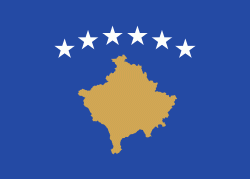Kosovo (Kosova or Kosovë ; ?????? ), officially the Republic of Kosovo (Republika e Kosovës; ????????? ??????), is a partially recognised state in Southeast Europe. It lies at the centre of the Balkans. Kosovo unilaterally declared its independence from Serbia on 17 February 2008, and has since gained diplomatic recognition as a sovereign state by member states of the United Nations. It is bordered by Serbia to the north and east, North Macedonia to the southeast, Albania to the southwest, and Montenegro to the west. Most of central Kosovo is dominated by the vast plains and fields of Metohija and Kosovo field. The Accursed Mountains and ar Mountains rise in the southwest and southeast, respectively. Its capital and largest city is Pristina.
In classical antiquity, the central tribe which emerged in the territory of Kosovo were the Dardani, who formed an independent polity known as the Kingdom of Dardania in the 4th century BC. It was annexed by the Roman Empire by the 1st century BC, and for the next millennium, the territory remained part of the Byzantine Empire, whose rule was eroded by Slavic invasions beginning in the 6th7th century AD. In the centuries thereafter, control of the area alternated between the Byzantines and the First Bulgarian Empire. By the 13th century, Kosovo became the core of the Serbian medieval state, and has also been the seat of the Serbian Orthodox Church from the 14th century, when its status was upgraded to a patriarchate. Ottoman expansion in the Balkans in the late 14th and 15th century led to the decline and fall of the Serbian Empire; the Battle of Kosovo of 1389 is considered to be one of the defining moments in Serbian medieval history. The Ottomans fully conquered the region after the Second Battle of Kosovo. The Ottoman Empire ruled the area for almost five centuries until 1912.

